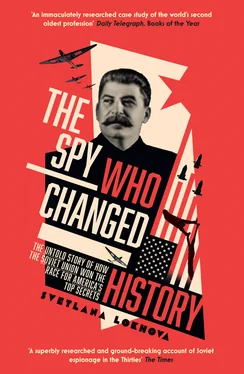In a more successful step, the Soviets translated Henry Ford’s works into Russian as essential reading for factory managers. There was an official government campaign to ‘Do It the Ford Way’. 6By such innovative manufacturing techniques of mass production, the United States had overtaken the British Empire as the world’s number-one economy, helped in part by the Great War. Imported to the Soviet Union, these same techniques were expected to bring about the inevitable triumph of socialism. Capitalism was a smart, inventive beast. American business, as well as Marx, had much to teach those embarking on the sure road to socialism. The US had met and defeated the same challenges that confronted the newly formed Soviet Union, including how to industrialise with only untrained, unskilled workers and few managers. The US was the teacher, the model of mass production, an urbanised country boasting the highest living standards in the world. Copying US techniques and methods would turn Russia’s army of uneducated, conservatively minded peasants, tied to their traditions and land, into a progressive communist urban proletariat.
From the 1920s, hundreds of Soviet engineers were sent abroad annually on short foreign trips for hands-on training with new technology. They were instructed to gather as much helpful information as they could on their visits. It was not a difficult task in the US. One engineer described his surprise at the openness of the Americans he met. While visiting a factory, he and his comrades would be given unhindered access to a broad range of technical data. They could make sketches and take copies back to the USSR free of charge. Their host company did not disclose its patented secrets, but everything else was considered advertising for the firm. From such early trips, the Soviet leaders gained the idea that America, more than any other country, was wide open to industrial espionage.
• • •
In October 1922, just a few weeks after the Reds’ victory in the Russian Civil War, an ex-Russian Orthodox seminary student and his close friend, a former Jesuit student, set in motion a more radical long-term reconstruction of Russia. In their frequent correspondence, they planned a transformation of their backward land, now shattered and starved by three wars and revolutions in short order. 7The lapsed Catholic, ‘Iron Felix’ Dzerzhinsky (his nickname arose on account of his ruthlessness and devotion to the Communist cause), was the founder of the Soviet security services. The former seminary pupil, Joseph Stalin, General Secretary of the Party, was on his path to become Lenin’s heir. In 1925, Dzerzhinsky became the first and only known intelligence chief to be given simultaneously a major economic post as Chairman of the Supreme Economic Council. The two friends could discuss almost anything.
In their shared desire for rapid change, Dzerzhinsky and Stalin emphasised the use of intelligence as one tool to tackle the economic crisis. Both men had a fine appreciation of the value of espionage: Dzerzhinsky was a spymaster, and his friend the most spied-upon man in history. Dzerzhinsky had a pivotal role in identifying the potential contribution of both Western technology and scientific and technological (S&T) espionage to the modernisation of the Soviet economy. He identified America, the world’s number-one technical innovator and leading industrial power, as a role model and target. Dzerzhinsky studied and grew to admire American industrial methods – most surprisingly those of the world’s first billionaire, Henry Ford, the pioneer of the industrial practices from which Dzerzhinsky believed the backward Soviet economy needed to learn. Dzerzhinsky wrote in 1925: ‘It is essential to engage in the study of Ford’s methods and their adoption in practice … Perhaps it would be worth recruiting from abroad practitioners and organisers of Fordism.’ 8Dzerzhinsky’s ideas and recommendations were incorporated into the Five-Year Plans – Stalin’s centrepiece programmes to industrialise the Soviet Union at breakneck pace. Ford’s top architect, Albert Kahn, was recruited to design and build Stalin’s giant dual military/civilian-use factories along Ford lines, and was responsible for establishing automotive, tractor and tank facilities in the Soviet Union.
On assuming control after the death of Lenin, the new leadership decided enough was enough and immediately galvanised the entire efforts of the state to build up heavy industry. Amid enormous publicity, Stalin announced the first Five-Year Plan in 1928. The first and second Five-Year Plans proposed the creation of new capital-intensive aviation, automobile, tractor and chemical industries. Stalin’s plans were on a truly grand scale and required building over 1,500 modern factories between 1928 and 1933; yet he understood that the Soviet Union’s early attempts at going it alone to develop industry without adequate foreign help had failed. The most notable example was the first project at the vast Magnitogorsk metallurgical plant. The inexperienced Soviets had tried to build the plant at breakneck speed, cutting corners; as a consequence, urgent and extensive repairs to the twin blast furnaces were needed just days after first starting them. The production of steel was pushed back years. The lesson of such failures was that the design and building of large, technically complex industrial facilities was beyond Soviet capabilities without significant long-term foreign expertise. The help of the West was required and was sought once more – this time in the new form of fee-based technical assistance programmes, not long-term concessions. Stalin’s proposed commercial terms were attractive to foreign companies, as they were for a limited period and so did not require risky long-term investment. During the Great Depression of the 1930s Western companies desperately needed large orders, allowing the Soviet Union the opportunity to acquire advanced technology and technical skills quickly and cheaply.
Under the standard terms of the contract, a foreign firm would provide the Russians with a complete description of a project including specifications of equipment, machines and mechanisms. They transferred all the technological secrets, including patents, and sent representatives to the USSR to supervise the construction and start-up of the facility. The Russians had to compensate the foreign company for the cost of manufacturing drawings, business trips and the work of its employees in the USSR and provide the necessary living conditions. The international company would receive a fixed profit as a percentage of the estimated cost of the work. The contribution of US companies and engineers to the success of the first Five-Year Plan was enormous, yet it is generally forgotten, especially in America. Around 1,700 US engineers entered Russia in 1929 to work on major industrial projects.
The plan to work closely with the US had its genesis in September 1927, when Stalin set up a permanent commission of the Politburo of the Communist Party of the Soviet Union to manage technical and scientific relations with the United States. He stated: ‘It is clear to me that the USA has more grounds for extensive business relations with the Soviet Union than any other country.’ 9
The vast new industrial capacity developed under supervision of US engineers boosted the economy. But most of them left in 1932–3 when hard currency ran out, sent home unless they would accept payment in roubles. From 1931 the USSR could only afford to import essential US technology. To survive on Stalin’s route to the future, there was a need for elite engineers able to invent local solutions. The Soviet government had sought from its international partner an efficient balance of trade and a long-term supply of credit, but the US refused. On 25 August 1931, Stalin declared:
Читать дальше












